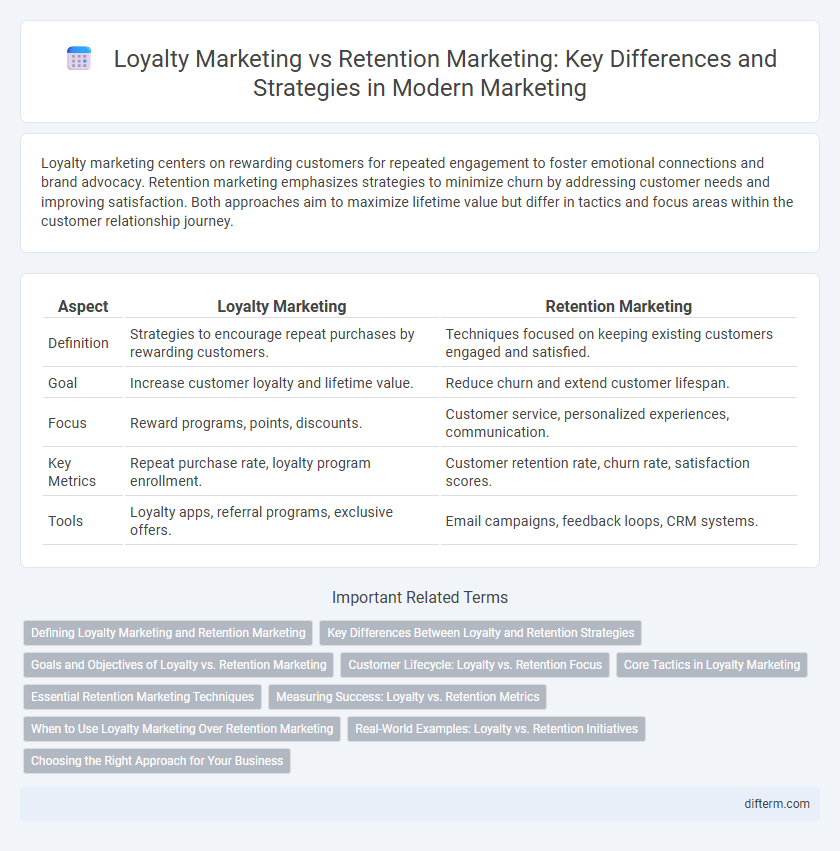Loyalty marketing centers on rewarding customers for repeated engagement to foster emotional connections and brand advocacy. Retention marketing emphasizes strategies to minimize churn by addressing customer needs and improving satisfaction. Both approaches aim to maximize lifetime value but differ in tactics and focus areas within the customer relationship journey.
Table of Comparison
| Aspect | Loyalty Marketing | Retention Marketing |
|---|---|---|
| Definition | Strategies to encourage repeat purchases by rewarding customers. | Techniques focused on keeping existing customers engaged and satisfied. |
| Goal | Increase customer loyalty and lifetime value. | Reduce churn and extend customer lifespan. |
| Focus | Reward programs, points, discounts. | Customer service, personalized experiences, communication. |
| Key Metrics | Repeat purchase rate, loyalty program enrollment. | Customer retention rate, churn rate, satisfaction scores. |
| Tools | Loyalty apps, referral programs, exclusive offers. | Email campaigns, feedback loops, CRM systems. |
Defining Loyalty Marketing and Retention Marketing
Loyalty marketing focuses on building long-term emotional connections with customers by offering rewards, personalized experiences, and exclusive benefits that encourage repeat purchases and brand advocacy. Retention marketing aims to reduce customer churn through targeted communication, problem resolution, and value reinforcement, ensuring customers continue using a product or service. Both strategies prioritize customer lifetime value but differ in approach; loyalty marketing emphasizes engagement, while retention marketing concentrates on sustaining existing customer relationships.
Key Differences Between Loyalty and Retention Strategies
Loyalty marketing focuses on rewarding repeat customers to encourage ongoing engagement through points, discounts, or exclusive offers, while retention marketing aims to reduce churn by improving customer satisfaction and addressing pain points. Loyalty strategies target emotional and behavioral connections to foster brand allegiance, whereas retention strategies prioritize personalized communication and service improvements to maintain active customers. Effective marketing plans integrate both approaches to maximize customer lifetime value and enhance overall brand growth.
Goals and Objectives of Loyalty vs. Retention Marketing
Loyalty marketing aims to deepen customer engagement by rewarding repeat behavior, fostering brand advocacy, and increasing customer lifetime value through personalized incentives and exclusive offers. Retention marketing focuses on reducing churn rates by addressing customer satisfaction, resolving pain points, and maintaining consistent communication to keep customers active. Both strategies prioritize long-term relationships, but loyalty marketing emphasizes emotional connection, while retention marketing prioritizes preventing customer loss.
Customer Lifecycle: Loyalty vs. Retention Focus
Loyalty marketing centers on rewarding customers to foster emotional connection and long-term brand advocacy, often leveraging personalized incentives and exclusive offers during the loyalty phase of the customer lifecycle. Retention marketing emphasizes reducing churn by addressing pain points and enhancing customer satisfaction primarily in the post-purchase and engagement stages. Effective marketing strategies balance both approaches to maximize customer lifetime value and sustain consistent revenue growth.
Core Tactics in Loyalty Marketing
Loyalty marketing core tactics include personalized rewards programs, exclusive member offers, and point-based incentives designed to increase customer lifetime value. These strategies emphasize emotional engagement by fostering brand affinity and encouraging repeat purchases through targeted communication and experiential benefits. Data-driven segmentation and behavior tracking enable brands to tailor offers that resonate deeply, distinguishing loyalty marketing from broader retention efforts.
Essential Retention Marketing Techniques
Essential retention marketing techniques include personalized communication, loyalty programs, and proactive customer service to increase customer lifetime value. Leveraging data analytics enables businesses to identify at-risk customers and tailor offers that encourage repeat purchases. Consistent engagement through multi-channel strategies enhances brand affinity and reduces churn rates.
Measuring Success: Loyalty vs. Retention Metrics
Loyalty marketing success is measured by metrics such as customer lifetime value (CLV), repeat purchase rate, and Net Promoter Score (NPS), reflecting deep brand engagement and advocacy. Retention marketing, on the other hand, focuses on churn rate, customer retention rate, and renewal rates to gauge effectiveness in maintaining active customers over time. Comparing these metrics helps marketers balance strategies that both foster emotional connection and sustain ongoing customer relationships.
When to Use Loyalty Marketing Over Retention Marketing
Loyalty marketing is most effective when businesses aim to deepen emotional connections and encourage repeat purchases through rewards, exclusive offers, and personalized experiences. It suits brands seeking long-term engagement by transforming satisfied customers into brand advocates, especially in competitive markets with high customer acquisition costs. Retention marketing is better for preventing churn and re-engaging at-risk customers through targeted communications and service improvements, while loyalty marketing emphasizes building ongoing, meaningful customer relationships.
Real-World Examples: Loyalty vs. Retention Initiatives
Loyalty marketing, exemplified by Starbucks Rewards, leverages point-based systems to incentivize repeat purchases and deepen emotional brand connections, driving higher customer lifetime value. Retention marketing, as demonstrated by Amazon's personalized recommendation engine, focuses on reducing churn by tailoring experiences that keep users engaged and satisfied over time. Both strategies illustrate how targeted initiatives enhance business growth through distinct, yet complementary, customer engagement tactics.
Choosing the Right Approach for Your Business
Loyalty marketing emphasizes rewarding repeat customers to encourage long-term engagement, while retention marketing focuses on minimizing churn by addressing customer satisfaction and experience. Selecting the right approach depends on your business model, customer lifecycle, and key performance indicators like customer lifetime value and churn rate. Analyzing customer behavior data and aligning marketing strategies with business goals ensures optimal investment in either loyalty or retention initiatives.
loyalty marketing vs retention marketing Infographic

 difterm.com
difterm.com